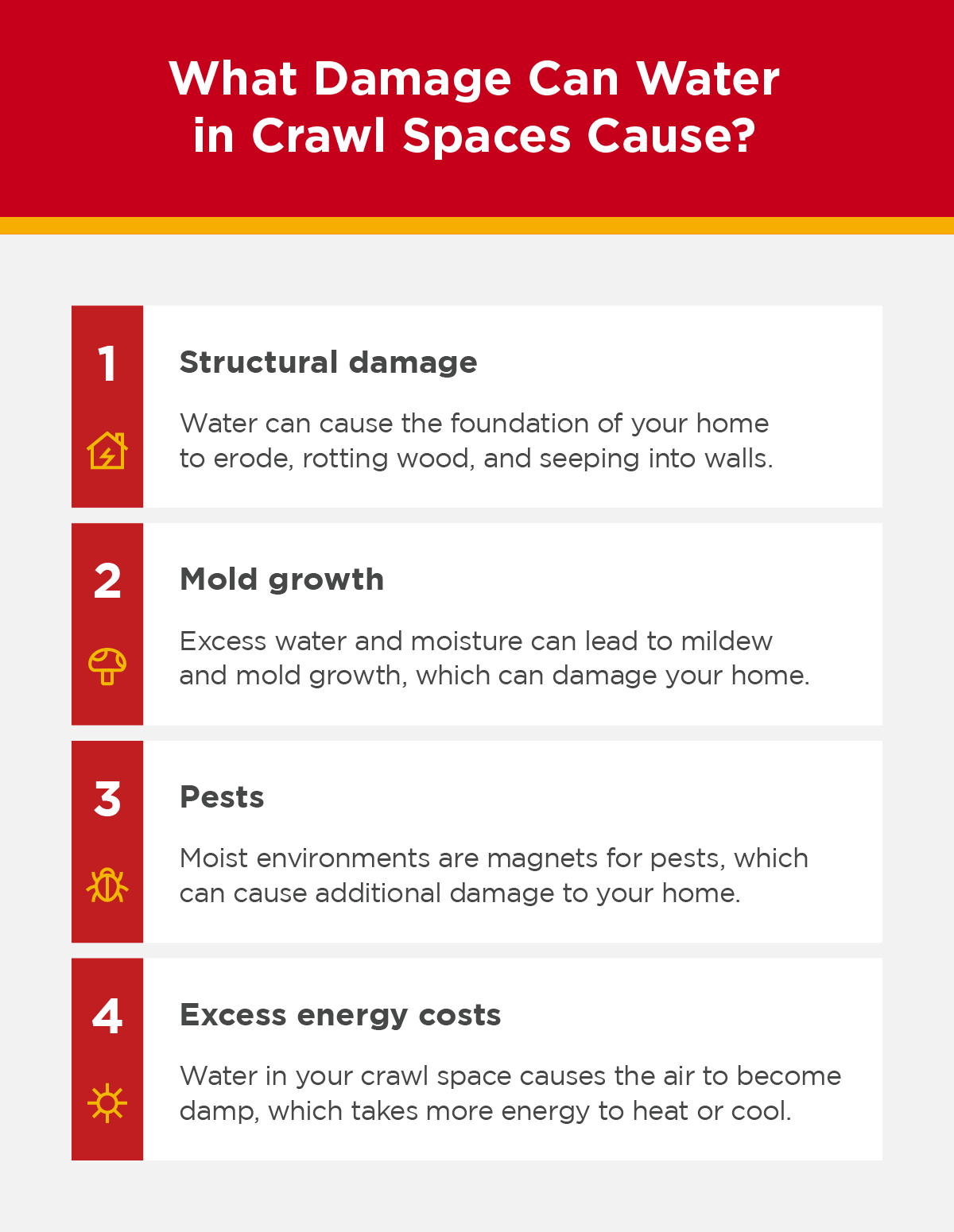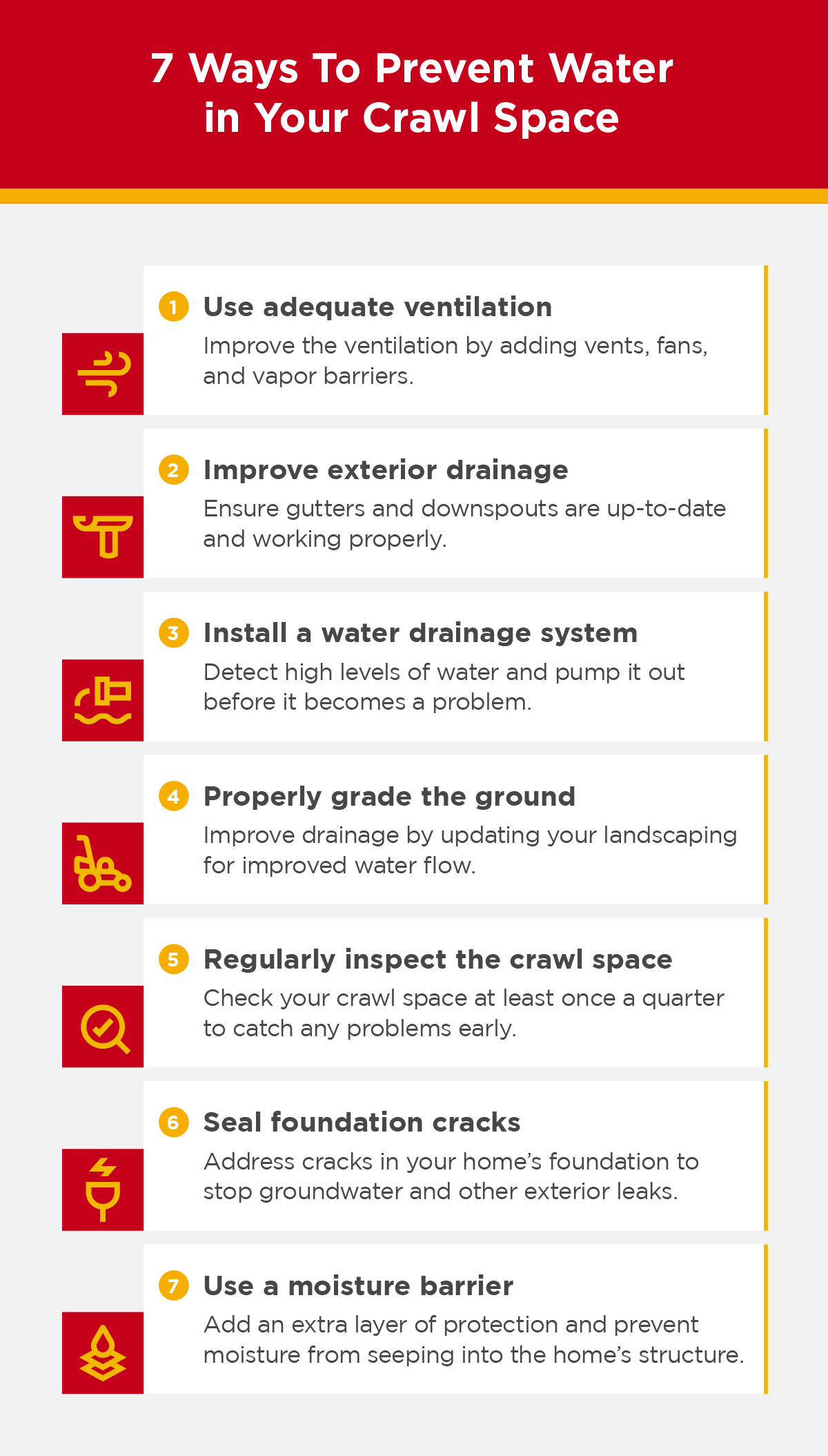Water in a Crawl Space: How To Act Fast and Prevent Damage
|
Tip: If you notice water in your crawl space, take action immediately by calling a professional for help. If you’re dealing with a large amount of water, you can get a jump on removing it with the help of a pump. |
There’s no worse feeling than having to wedge yourself underneath your home and noticing the unwelcome sight of water in your crawl space.
Whether you’re dealing with a flooded crawl space or some concerning moisture, the good news is that there are steps you can take to resolve the issue—you just need to act quickly. Let’s understand what causes water in crawl spaces, how you handle water in a crawl space, and how you can protect your crawl space from water damage in the future.
Damage Caused by Water in a Crawl Space
Just like in any other area of your home, water in your crawl space is unwelcome at best and potentially dangerous at most. Water in your crawl space can cause:
Structural damage
One of the most serious side effects of water in a crawl space is structural damage to your home. If water lingers for long enough, it can cause your home's foundation to erode, rotting the wood, seeping into the walls, and causing support beams, columns, and posts to sink, slant, or sag in soggy ground. Once these sort of shifts happen in the foundation of a home, they are very difficult (and costly) to fix.
Mold growth
Excess levels of water and moisture in a crawl space can also lead to mildew and mold growth. This is potentially very dangerous since mold is known to cause a number of health issues, which could affect you and your family if water in your crawl space is left undetected or unaddressed.
Invite Pests
To make matters even worse, moist environments are magnets for pests, especially termites, who are attracted to rotting wood. In addition to structural damage from moisture, you may also have to deal with damage caused by termites.

How To Handle Water in a Crawl Space
If you notice water in the crawl space of your home, it’s best to reach out to a professional immediately. The damage from sitting water can be significant (and can also reach much farther down into the home’s foundation that you may be able to see). A professional like Mr. Handyman® can assess your situation and come up with a solution.
Since crawl spaces are not particularly popular areas of the home, one of the biggest issues with crawl space water damage is that it can be weeks, months, or even years until someone notices the issue.
And since the water’s time of origin is unknown, this means that there are also unknown levels of danger associated with entering the area. Especially in the case of standing water in a crawl space, floors may be bouncy or eroded, and the foundation may have become unstable and not fit for entry.
Don’t risk DIY—reach out to professionals immediately if you observe water in your crawl space.
How Can Water Get Into a Crawl Space?
There are a number of different ways water can get into a crawl space, and the source of the water will determine next steps.
- Foundation cracks: If there are cracks in the foundation, it’s easy for water to seep through and cause a water leak under the house.
- Groundwater: Groundwater can easily get into your crawl space if the grading of your home is uneven or sloping towards your house.
- Leaking pipes: Leaks from pipes and plumbing fixtures are bad anywhere in the house, and the crawl space is no exception, since these leaks can cause water to accumulate.
- Poor drainage: Often a major contributor to the buildup of water in crawl spaces, drainage issues can occur because of clogged gutters or sloped landscaping.
- Rainwater: Water in a crawl space after heavy rain is a common issue. Rain can easily enter the crawl space through gutters that are clogged or downspouts that direct water too close to the house. Both can increase the amount of water that pools around the foundation, raising the likelihood of seepage.

7 Ways To Prevent Water in Your Crawl Space
You can hopefully save yourself costly expenses of repairing water damage in your crawl space by taking preventative action to protect your home from water damage.
- Use adequate ventilation: If your primary crawl space issue is the buildup of moisture from humidity, you can easily improve ventilation by adding vents, fans, and vapor barriers.
- Improve your exterior drainage: Ensure exterior drainage systems, such as gutters and downspouts, are updated and working properly.
- Install a water drainage system: Installing a sump pump is a great way to proactively handle water buildup, since the system can automatically detect high water levels and start pumping out water before it becomes a problem.
- Properly grade the ground: If the ground around your home naturally slopes toward the house, you’ll want to improve drainage by updating your landscaping with the help of a professional.
- Regularly inspect the crawl space: The easiest way to get ahead of water in crawl space damage is to inspect it regularly, especially after rainstorms.
- Seal foundation cracks: Address cracks in the foundation of your home with the help of a professional to stop groundwater and other exterior leaks from causing water buildup in your crawl space.
- Use a moisture barrier: A moisture barrier like plastic or foil can provide an extra layer of protection in your crawl space to prevent moisture from seeping into the home’s structure.

Will Insurance Handle Water in Your Crawl Space?
Insurance coverage varies greatly by company and plan, so you may or may not be able to receive support for water damage in your crawl space.
If you have a water leak in your home, your homeowners insurance may cover it. Some insurances will cover foundation leaks, but not if they're caused by natural elements. Check with your provider if your standard homeowners insurance covers flood damage.
Turn to Mr. Handyman To Help Remove Water in Your Crawl Space and Repair the Damage
Wondering who to call for water in a crawl space? Let Mr. Handyman help! With nearly 200 locations across the United States and Canada and over 25 years of experience, you can trust your local Mr. Handyman team of home improvement professionals to care for your home.
Contact us today, and we’ll call you to set up a service.
This article is intended for general informational purposes only and may not be applicable to every situation. You are responsible for determining the proper course of action for your home and property. Mr. Handyman is not responsible for any damages that occur as a result of this blog content or your actions. For the most accurate guidance, contact your local Mr. Handyman location for a comprehensive, on-site assessment.
Water in Crawl Space FAQs
Mr. Handyman has been helping homeowners repair, maintain, and enhance their spaces for over 25 years! We are the one-stop solution for everything on your to-do list. This includes answering your questions about home repairs, maintenance, and improvements. Here are answers to some of your most frequently asked questions about water in a crawl space.
How serious is water in a crawl space?
Very. Water in your home’s crawl space is a big problem that should not be put off! Crawl space water can lead to foundation issues with your home, health issues due to mold growth and pest infestations, and excessive energy prices. If you notice water in your crawl space, reach out to a professional as soon as possible.
How do I get water out of my crawl space?
You can use a number of tools to get water out of your crawl space, such as a pump, a wet/dry shop vac, a dehumidifier, and fans. However, these tools won’t help if you don’t address the root of the problem that causes water buildup in the first place.
What do I do if my crawl space is flooded?
If your crawl space is flooded, you’ll need to first remove the water. You can do this with the help of a pump or wet/dry shop vac, or call a professional for assistance.
Once the water has been removed, you can dry the space using fans and dehumidifiers. You'll need to identify whether this flooding was a one-time incident or if you’re dealing with a chronic issue. Revisit the flooding site frequently over the next several months.
How can you dry out a crawl space quickly?
The quickest way to dry out a crawl space is with the help of a heat source, a dehumidifier, and powerful fans. Professionals can help you dry out a crawl space more quickly.
 Click to call
Click to call


